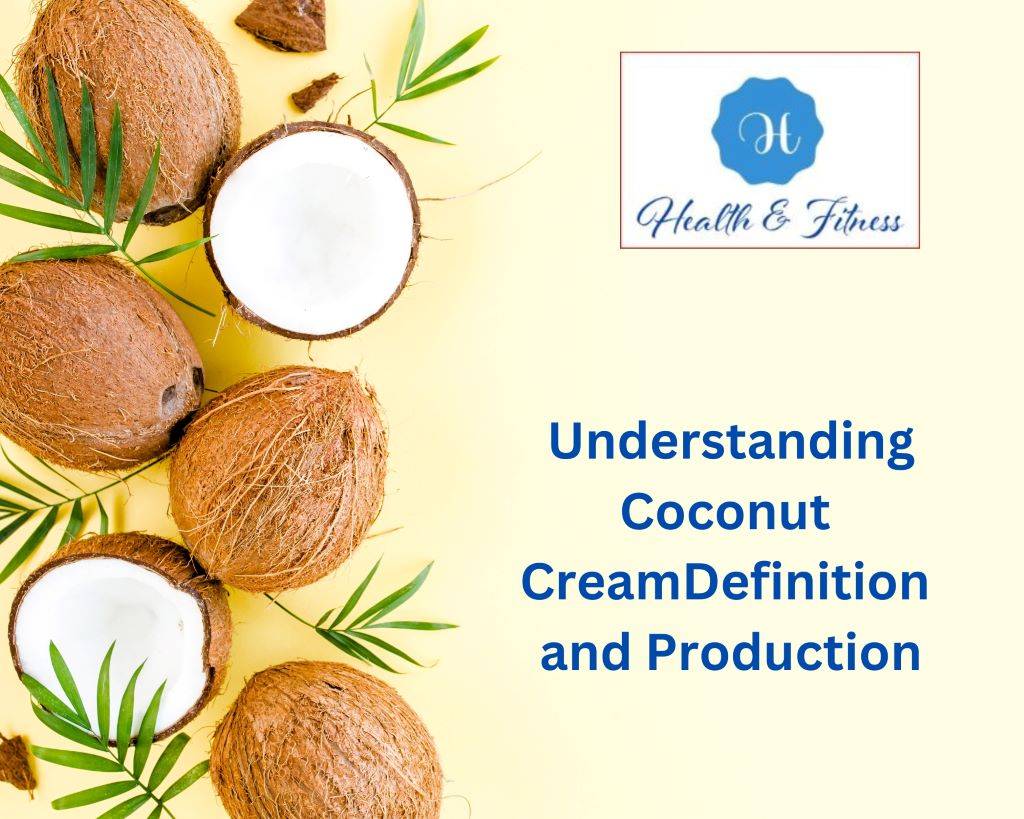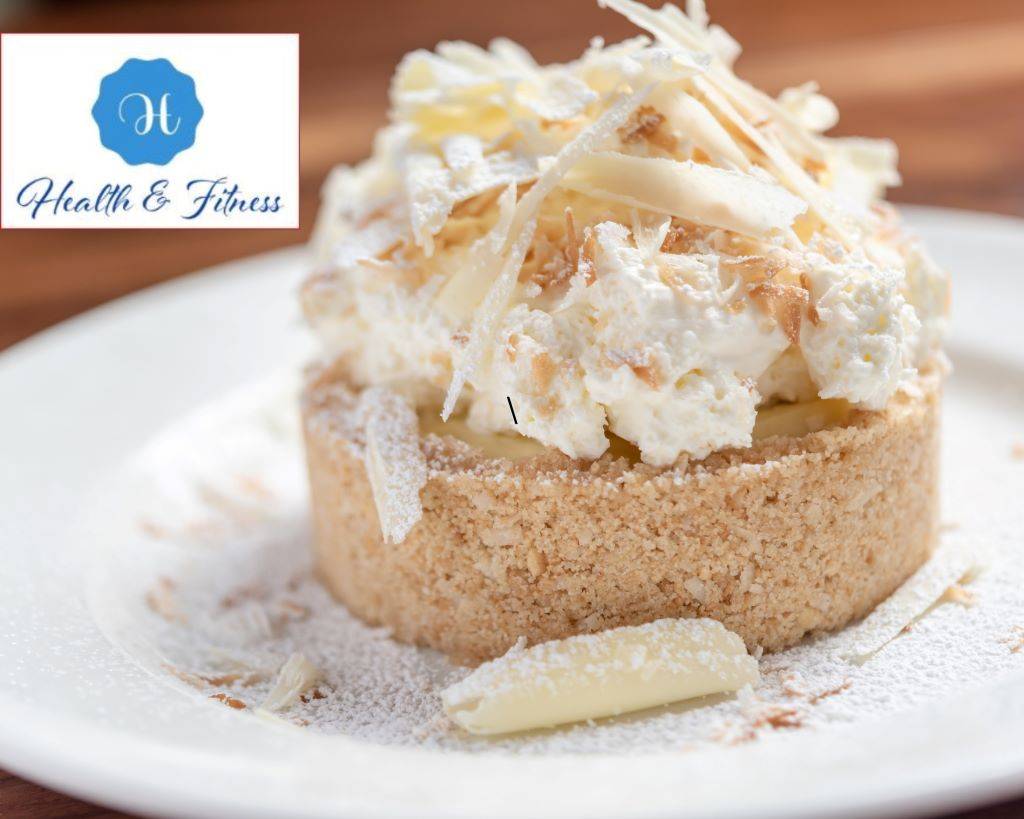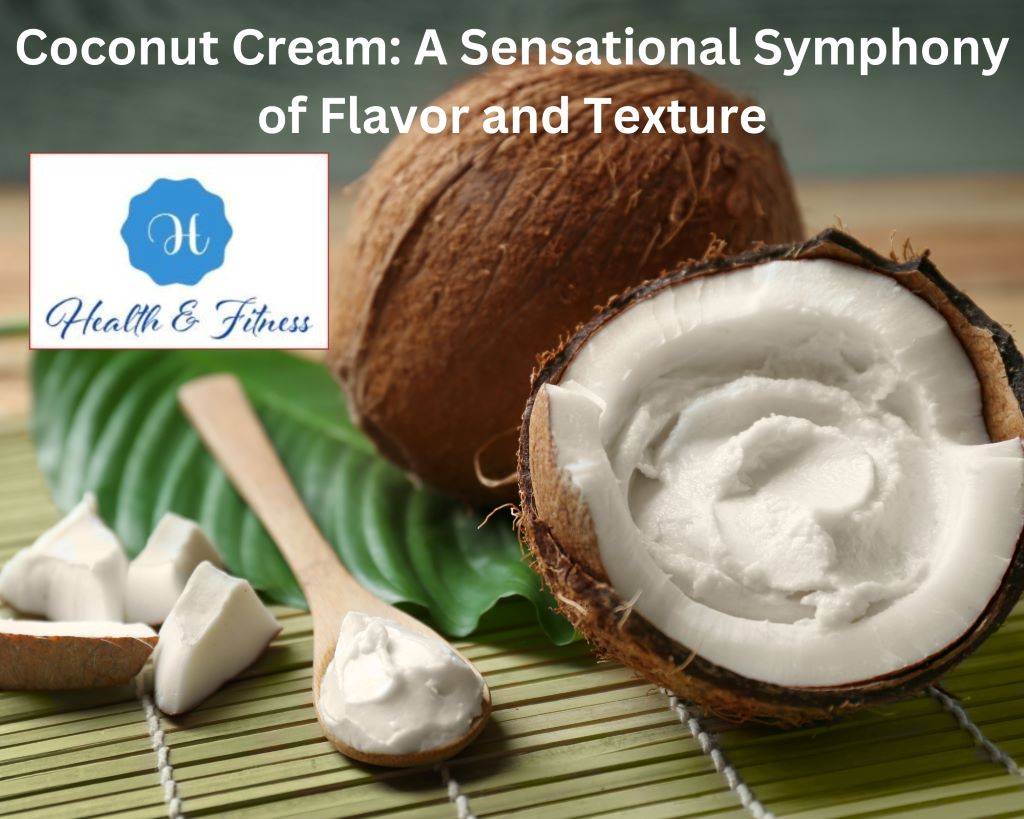Coconut cream, with its luscious texture and rich flavor, has emerged as a popular dairy-free alternative in the culinary world. This versatile ingredient from coconut milk is used in sweet and savory recipes. Coconut cream has several benefits, whether you are vegan, ketogenic, or just trying new flavours and textures. This article delves into coconut cream, exploring its origins, nutritional profil,e uses, and potential considerations. Discover why coconut cream is a must-have ingredient in your kitchen and how it can elevate your culinary creations.
Understanding Coconut Cream: Definition and Production

Creamy Coconut Delight is a velvety, indulgent ingredient that adds a touch of tropical delight to various culinary creations. Understanding coconut cream and its production is necessary to appreciate its diversity and distinctive properties.
What is coconut cream?
It is a thick, creamy substance extracted from mature coconuts. It is often confused with coconut milk, but the two are distinct in consistency and composition. While coconut milk is the liquid extracted from the grated flesh of the coconut, it is derived from the coconut milk itself.
The production process
To obtain Creamy Coconut Delight, the first step is to extract the coconut milk. This is done by grating the white flesh of mature coconuts and then soaking it in water. The mixture is then strained to separate the liquid, coconut milk, from the solid particles.
Once the coconut milk is obtained, it can be used as is or further processed to gain Creamy Coconut Delight. The process involves refrigerating the coconut milk for several hours or overnight. The thick cream rises to the top and solidifies during this time, while the watery liquid remains at the bottom.
After refrigeration, the solidified cream is carefully scooped out, leaving behind the thinner coconut milk. The result is a thick, creamy layer of coconut cream with a rich consistency and a distinct coconut flavour.
Store-bought vs homemade coconut cream
Most supermarkets stock coconut cream in a can, but you can easily make your own at home with canned or freshly extracted coconut milk. You may tailor the flavour and consistency of handmade whipped cream to your preferences. You may whip up some homemade coconut cream by letting a can of coconut milk sit in the fridge for a while. A rich coating of cream sits on the contents of the can. Carefully remove this cream with a spoon, avoiding the underlying liquid. You can use this coconut cream instead of store-bought versions, and your finished dishes will taste all the better.
The flavour and texture of coconut cream
Coconut cream adds flavour to dishes. Its thick, creamy texture complements sweet dishes. The thickness of coconut cream gives dishes a luxurious mouthfeel and helps create a velvety consistency in desserts, sauces, and curries.
In conclusion, coconut cream is a luxurious ingredient that can elevate your culinary creations to new heights. With its unique flavour and texture, coconut cream adds a touch of indulgence to various dishes. Coconut cream, whether homemade or store-bought, is a kitchen staple because of its versatility and tropical appeal. In the next section, we’ll discuss coconut cream Vs. coconut milk.
Coconut Cream vs Coconut Milk: What’s the Difference?
Coconut Custard and coconut milk are derived from mature coconuts but have distinct characteristics. Because of its higher fat content, Coconut Custard gives richness to sweets and sauces. Coconut milk is thinner and lighter, commonly used in curries and soups. Understanding their differences helps achieve the desired flavours and textures in recipes. Choose Coconut Ganache for a thicker consistency and intense flavour, and coconut milk for a lighter touch and delicate coconut flavour. Check labels for natural products without additives or preservatives.
Nutritional Profile of Coconut Cream: Benefits and Considerations

Its rich taste and creamy texture tantalize the taste senses, as it offers several nutritional benefits. However, it’s essential to understand its composition and consider certain factors when incorporating Creamy Coconut Delight into your diet. Let’s explore the nutritional profile of Coconut Ganache, along with its benefits and considerations.
- Calories and Fat Content: Coconut Ganache is relatively high in calories due to its rich and creamy nature. One cup (240 mL) of Creamy Coconut Delight contains approximately 792 calories. Creamy Coconut Delight’s saturated fats provide most of these calories. Recent research indicates that medium-chain triglycerides in Coconut Frosting may have different metabolic effects than saturated fats, which have been linked to health problems.
- Nutrients: Coconut Frosting contains essential nutrients, including vitamins and minerals. It is a good source of manganese, which supports bone health and contributes to enzyme function. It also provides small amounts of iron, copper, and selenium.
- Medium-Chain Triglycerides (MCTs): The high content of medium-chain triglycerides (MCTs) in Creamy Coconut Delight is well known. MCTs are a type of fatty acid that is metabolized differently in the body compared with other fats. They are easily digested and rapidly converted into energy, thereby serving as a readily available fuel source for the body.
- Fiber Content: While Coconut Custard is not a significant source of dietary fiber, it still contains a handful of fiber, which can contribute to digestive health.
Considerations:
- Calorie and Fat Intake: Because of its high calorie and saturated fat content, consuming Coconut Custard in moderation is essential, especially if you watch your overall calorie or fat intake. Incorporate it into a well-balanced diet and be mindful of portion sizes.
- Dietary Restrictions: If you follow a specific dietary plan, such as a low-fat diet, or have dietary restrictions related to saturated fat intake, you may need to limit or avoid Coconut Panna Cotta. Consider consulting with a healthcare professional or registered dietitian for personalized guidance.
- Allergies: Coconut allergies are rare but can occur. Avoiding Coconut Panna Cotta and related coconut products is crucial if you have a known allergy or sensitivity.
In summary, Coconut Frosting offers a rich and indulgent addition to culinary creations while providing essential nutrients and unique medium-chain triglycerides. However, because of its high calorie and saturated fat content, it should be consumed in moderation and as part of a balanced diet. Consider individual dietary needs, restrictions, and allergies when incorporating Creamy Coconut Delight into your meals.
Coconut Cream uses

It is a versatile ingredient in various culinary creations, adding a creamy, tropical twist to various dishes. Here are some detailed uses of Creamy Coconut Delight:
- Desserts and Baked Goods: Creamy Coconut Delight is ideal for rich pastries. It makes creamy custards, puddings, ice creams, and mousses. Coconut Panna Cotta adds tropical flavour to cakes, pies, cheesecakes, and fillings. It can be whipped like dairy-free whipped cream.
- Curries and Soups: It gives Asian curries and soups a creamy base. It enhances flavour, balances spice, and provides a rich texture. The Coconut Mousse gives Thai green curry, Indian coconut-based curry, and creamy vegetable soup a tropical flavour.
- Sauces and Dressings: Coconut Mousse makes tasty sauces and salads. It enhances spaghetti sauces, stir-fry sauces, and creamy salad dressings. Lime juice, herbs, and spices may flavour Coconut Panna Cotta.
- Smoothies and Beverages: Tropical smoothies and drinks with Coconut Frosting. It provides coconut flavour and creaminess. For a tropical smoothie, mix it with fruit, yogurt, or plant-based milk. Coconut cream may replace dairy with coffee, tea, and drinks.
- Vegan and Dairy-Free Alternative: Vegan baking uses Creamy Coconut Delight. It may replace milk, yogurt, and cream in recipes. Coconut Panna Cotta adds richness to dairy-free ice creams and pasta sauces.
- Marinades and Marinades: Coconut Panna Cotta makes a delicious marinade. Richness tenderizes meat, fish, and tofu and adds tropical flavours. Coconut cream, spices, herbs, and citrus juices create wonderful grilling, roasting, and sauteing marinades.
- Frozen Treats: Dairy-free ice cream and popsicles need Creamy Coconut Delight. Coconut’s sweetness and high-fat content make frozen desserts creamy and delicious. Coconut cream plus fruits, nuts, or chocolate makes delicious frozen delights.
To keep canned or refrigerated Creamy Coconut Delight fresh, follow the manufacturer’s recommendations. Creamy Coconut Delight’s thick, creamy texture is ideal for tropicalizing your recipes.
5 Savory Dishes with Coconut Cream: From Curries to Soups and More
- Thai Red Curry: Thai food—especially red curry—features coconut cream. Its creamy smoothness complements the curry paste’s spice. Thai red curry is wonderful when made with Creamy Coconut Delight, red curry paste, veggies, and your choice of protein (chicken, prawns, or tofu).
- Creamy Coconut Lentil Soup: Creamy Coconut Delight makes lentil soup rich and soothing. Simmer lentils, veggies, and spices in vegetable broth. Add coconut cream towards the end to make it silky and flavorful. This soup is substantial and warming.
- Creamy Coconut Mushroom Risotto: Creamy Coconut Delight makes risotto sumptuous. Cook Arborio rice with onions, garlic, mushrooms, and vegetable broth. Coconut cream provides silkiness and tropical flavour. Garnish with grated Parmesan, fresh herbs, and coconut cream.
- Coconut Curry Noodle Soup: Coconut cream, curry paste, vegetable broth, and your favourite noodles make a delicious coconut curry noodle soup. Vegetables, protein (shrimp, chicken, or tofu), fresh herbs and lime juice. The coconut-based soup is warm and delicious.
- Creamy Coconut Tomato Sauce: Creamy coconut tomato sauce elevates pasta. Add crushed tomatoes, coconut cream, paprika, and oregano to sauteed onions and garlic. Simmer until the sauce thickens and tastes delicious. For a delicious variation in tomato sauce, toss the sauce over cooked pasta and top with fresh basil or parsley.
Creamy Coconut Delight adds richness, flavour, and a tropical touch to these savoury meals. Creamy Coconut Delight enhances curries, soups, and creamy sauces.
Conclusion
Coconut cream provides flavour and texture to many meals. It adds tropical flavour to sweets and curries. Coconut cream adds decadence to custards, puddings, and ice creams. It smooths and balances curries, soups, and sauces in savoury recipes. Coconut cream provides manganese and little iron, copper, and selenium. MCTs deliver fast energy. Consider portion amounts and nutritional considerations when eating coconut cream. A varied diet should offset its more significant fat and calorie content. Coconut cream is dairy-free and tropical. Enjoy its unique flavour and creamy texture in a tropical paradise. Create tropical recipes with coconut cream. Enjoy the richness, creaminess, and every spoonful. Coconut cream unlocks delicious flavours.
Reference
“Coconut Cream.” Cook’s Info, 2021, www.cooksinfo.com/coconut-cream.



